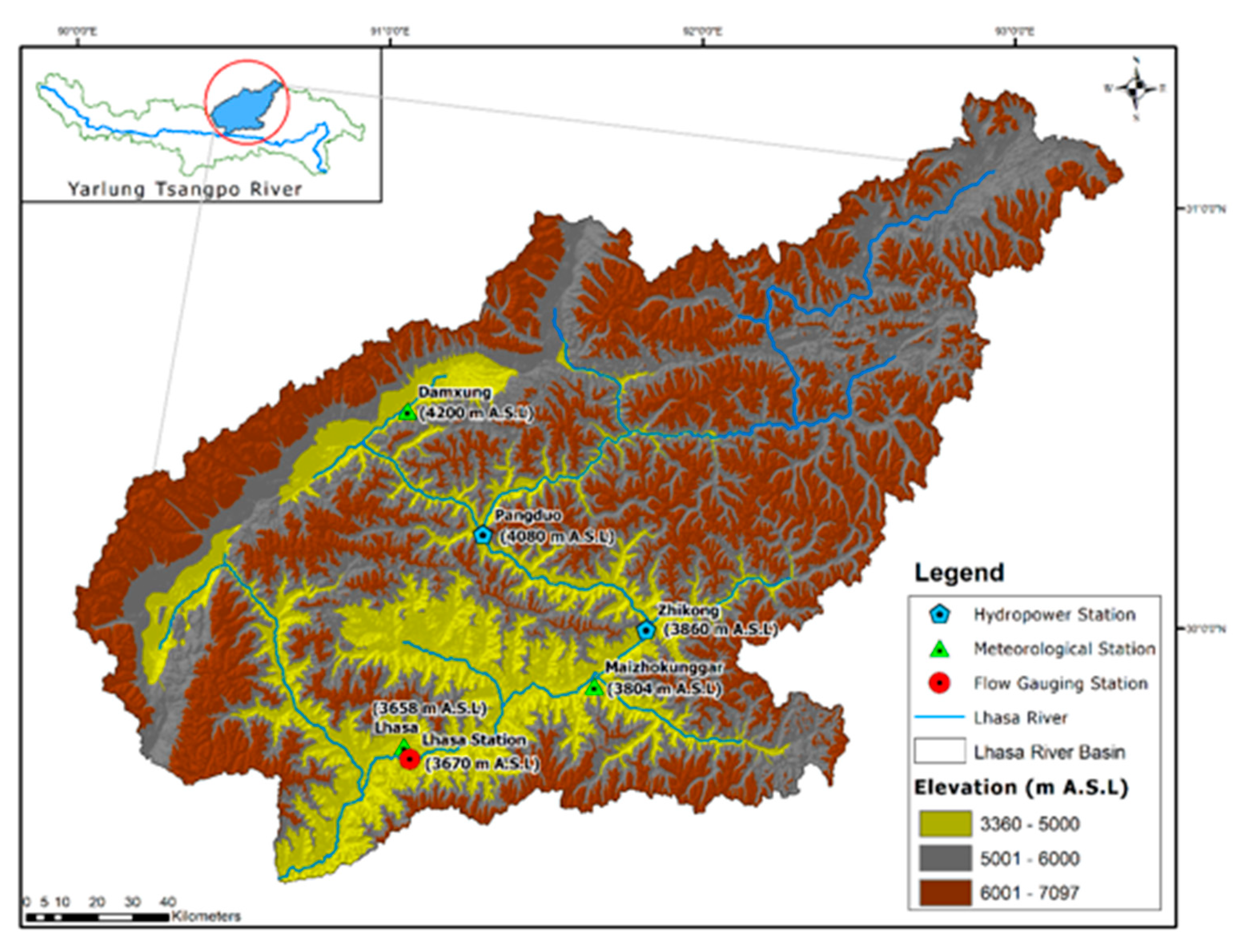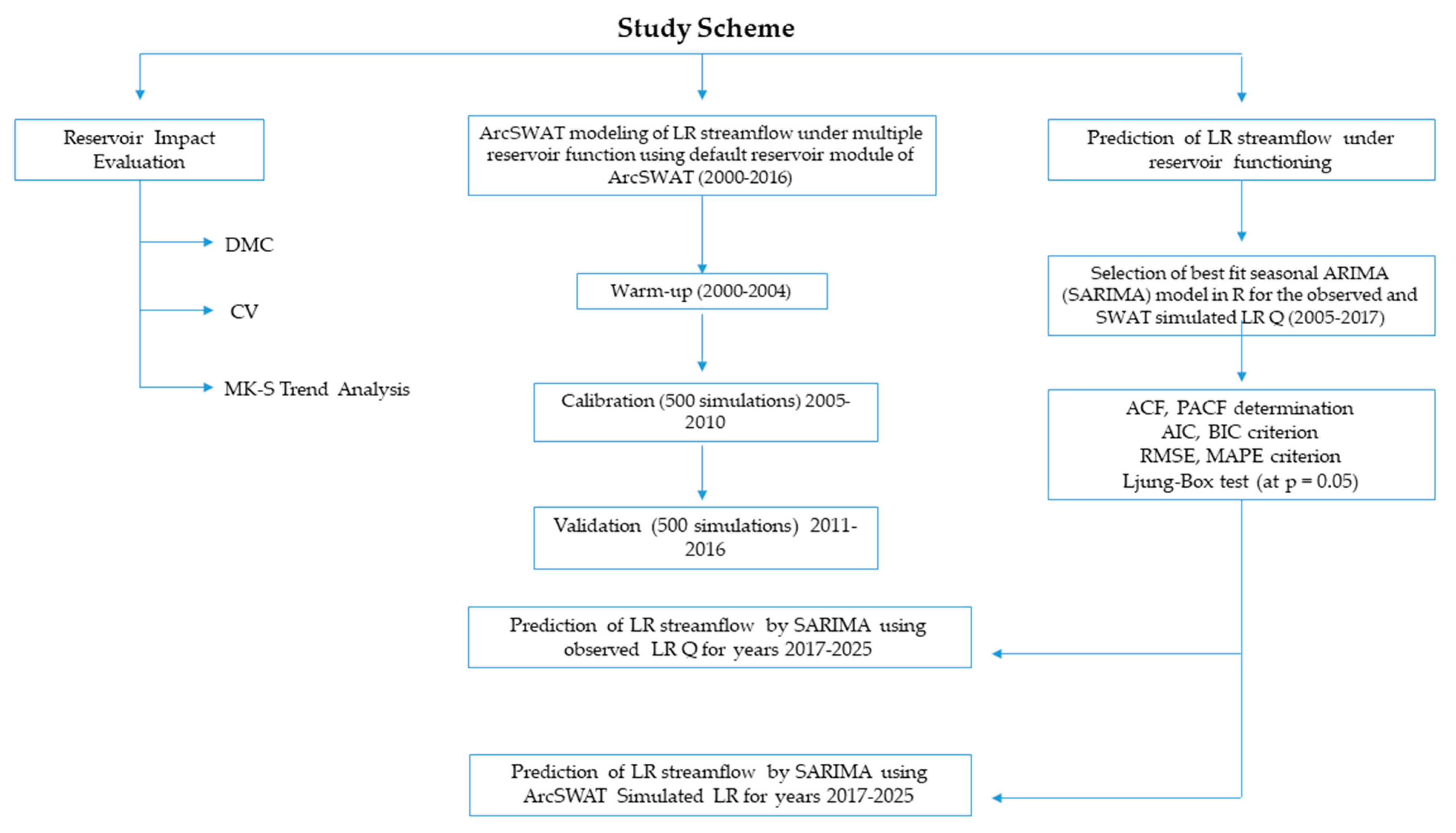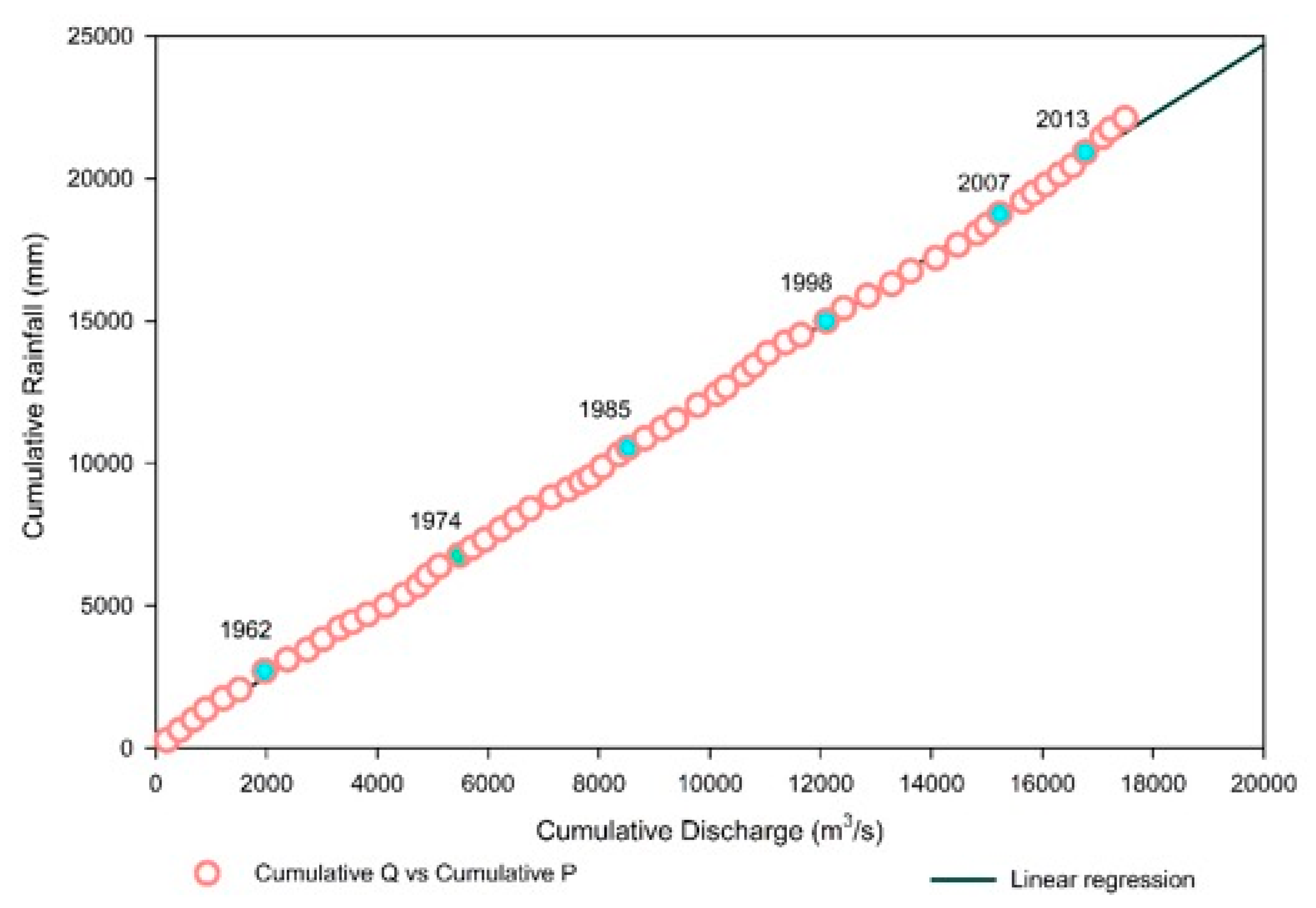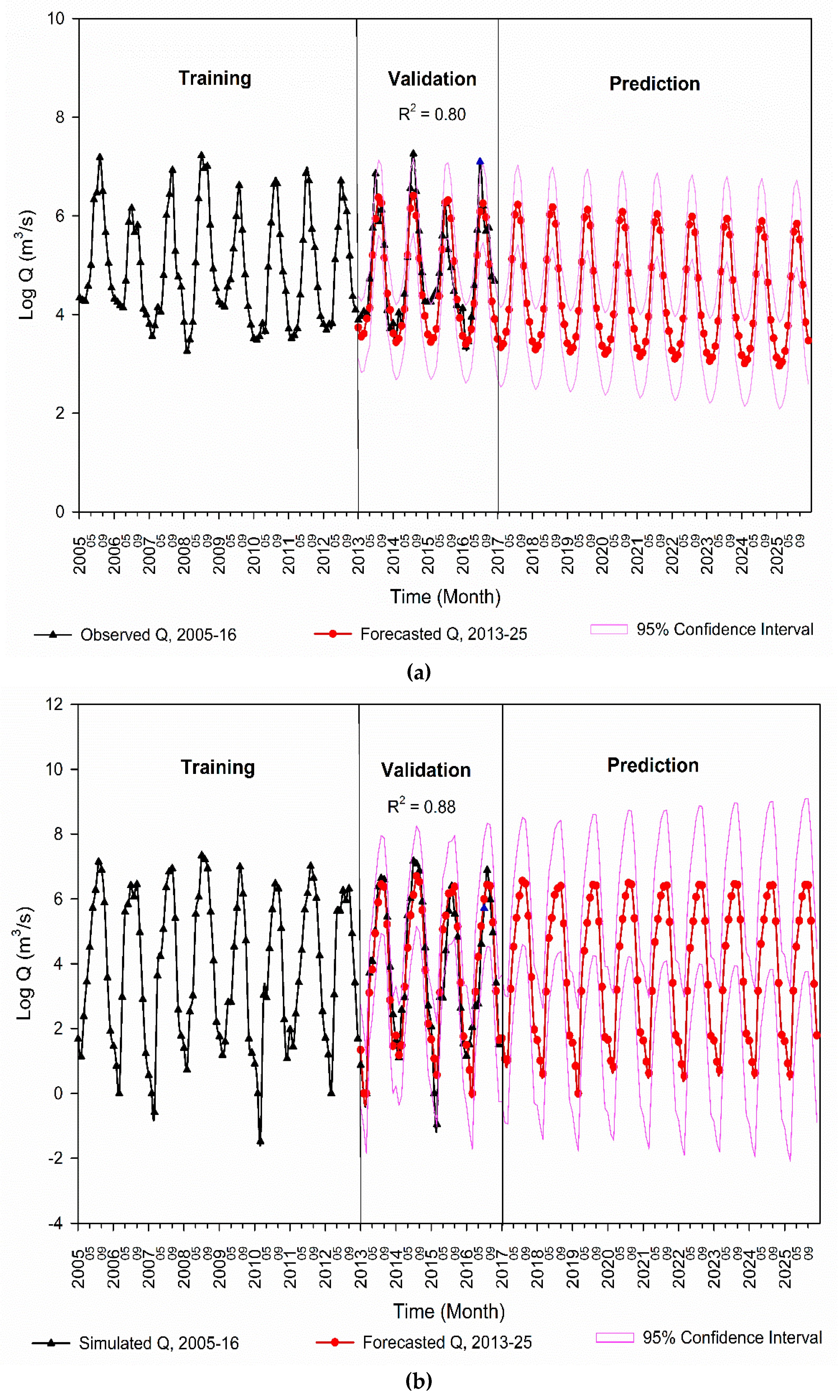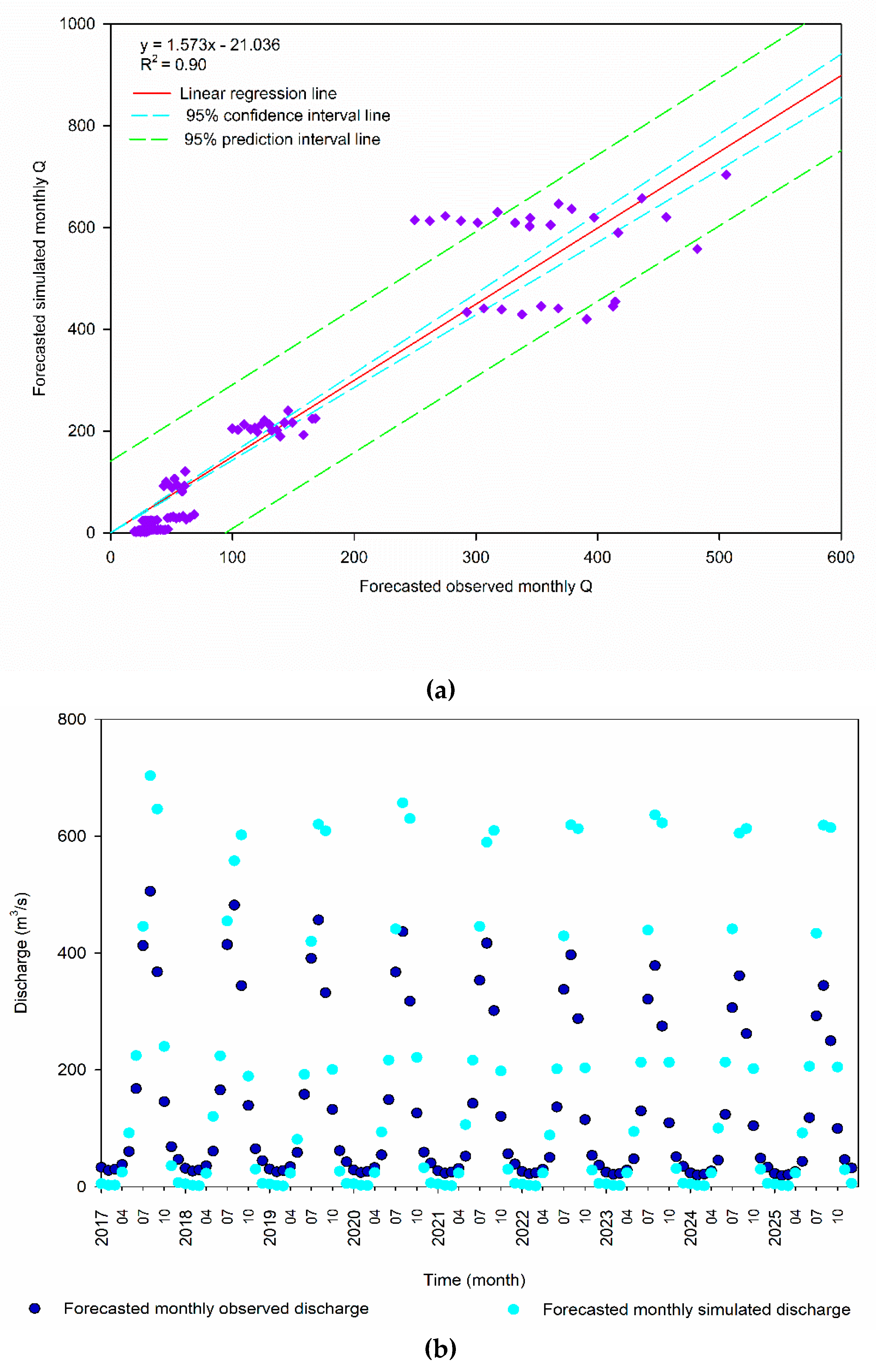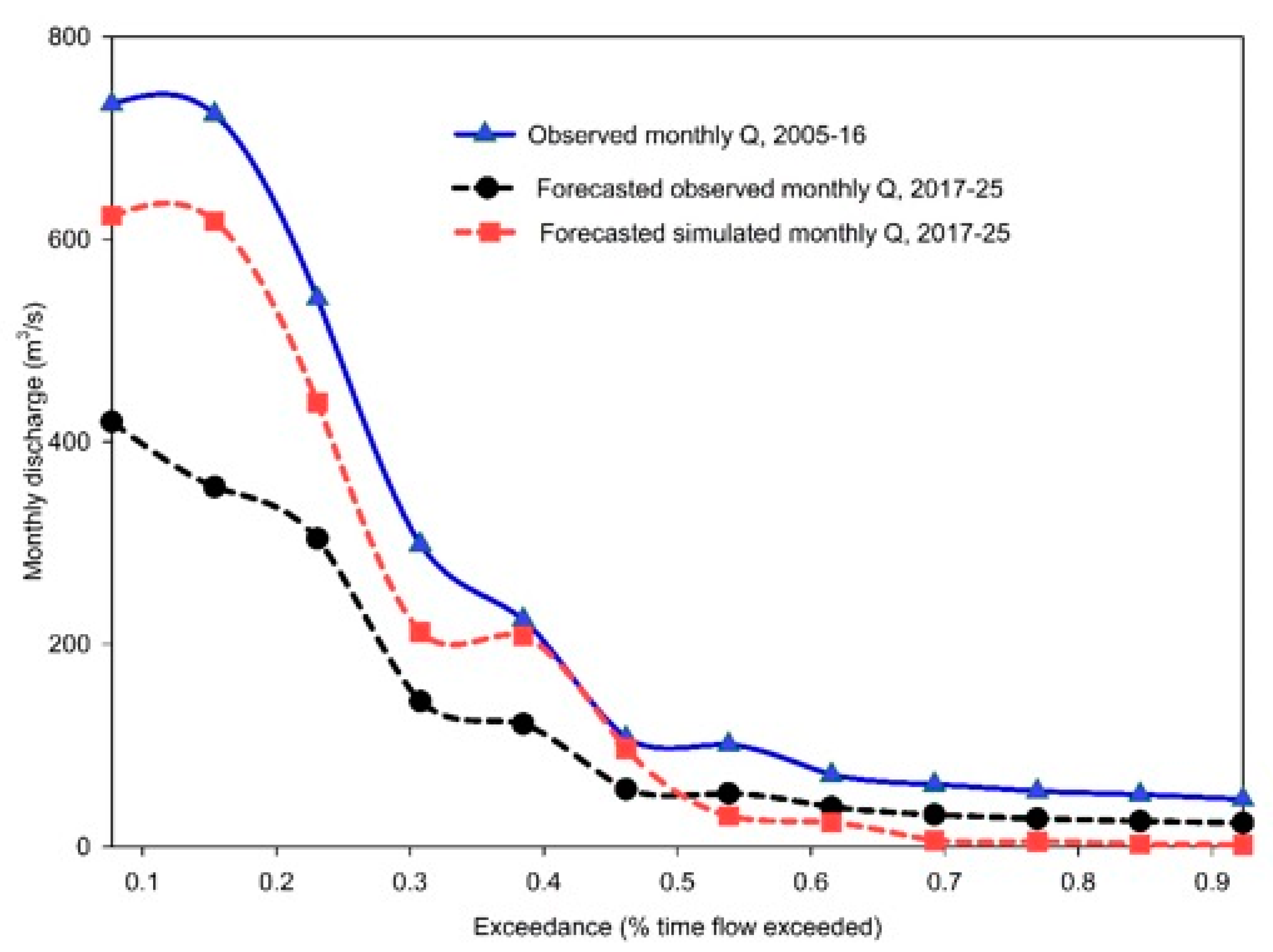1. Introduction
Dams are intended to offer substantial aid to humankind by ensuring an enhanced water availability for municipal, industrial, and agricultural uses, as well as increased capability of flood regulation and hydropower generation [
1]. On the other hand, the construction of dams has considerably changed the natural flow regime of rivers worldwide. Above half of the 292 large river systems in the world have been affected by dams [
2,
3]. The influence of human activities in altering river discharge has profoundly increased in recent decades [
4]. Over an intermediate time scale (e.g., decadal scale), human interferences in terms of water consumption, land-use change, dam construction, and sand mining, among others, are the powerful factors that escalate basin-scale hydrological changes. Therefore, a site-specific study is needed to disclose the governing effects of human disruptions on these hydrological changes [
5,
6,
7].
To temper river floods, reduce water collection for irrigation, hydropower generation and facilitate navigation, dams have been created across big rivers around the world [
8]. Dams have grown to one of the most perturbing human intrusions in river systems as the number of dams and the total storage capacity of reservoirs rapidly increase [
4]. Therefore, knowledge of dam construction and its regulating effects on river discharge is crucial for river and delta management and restoration. Highly regulated rivers in China are subject to large-scale ecosystem amendments made by hydrological alterations. Many of the earlier studies related to dam-induced hydrological alterations across river basins in China focused on the impacts of large dams that generally aim to control floods in large basins, such as the Lancang River [
9], the Mekong River [
10], the Pearl River [
11], the Yangtze River [
12], and the Yellow River [
13,
14]. In addition to large dams, the development of small dams has also been highlighted in national energy policies in China [
15]. Therefore, small dam construction is intense in China, especially in South China, where hydropower resources are extensive. Thus, to fill in the knowledge void, the present study focused on the impact appraisal of reservoir functioning in the Lhasa River Basin, a Qinghai–Tibetan Plateau basin in South China (for more information, see
Section 2.2). Several researchers have established a number of approaches with the objective of reckoning of the hydrologic modifications caused by human activity. However, hydrological modeling can be an effective alternative for hydrological analysis in different scenarios [
16]. The SWAT (Soil and Water Assessment Tool) model developed by the authors of [
17] has already been in widespread use for water resource management in many different rivers [
18,
19,
20,
21,
22,
23]. Additionally, there has been a general lack of applications of physically-based hydrological models to the Yarlung Tsangbo River Basin, especially the Lhasa River Basin [
24]. The SWAT model was applied to the Lhasa River Basin in a recent study [
25], where streamflow and sediment load were predicted for the Lhasa River in future. The SWAT model was applied to the Lhasa River Basin to simulate its streamflow variability under reservoir influence [
26]. The SWAT model was utilized in [
27] for hydrological drought propagation in the South China Dongjiang River Basin using the “simulated–observed approach”. Their study estimated the effects of human regulations on hydrological drought from the perspective of the development and recovery processes using the SWAT model.
Streamflow forecasting is of great significance to water resource management and planning. Medium-to-long-term forecasting including weekly, monthly, seasonal, and even annual time scales is predominantly beneficial in reservoir operations and irrigation management, as well as the institutional and legal features of water resource management and planning. Due to their reputation, a large number of forecasting models have been developed for streamflow forecasting, including concept-based, process-driven models such as the low flow recession model, rainfall–runoff models, and statistics-based data-driven models such as regression models, time series models, artificial neural network models, fuzzy logic models, and the nearest neighbor model [
28]. Of various streamflow forecasting methods, time series analysis has been most widely used in the previous decades because of its forecasting capability, inclusion of richer information, and more systematic way of building models in three modeling stages (identification, estimation, and diagnostic check), as standardized by Box and Jenkins (1976) [
29]. The current study made use of "simulated–observed approach" after [
27] for predicting the Lhasa River streamflow under reservoir operations in the Lhasa River Basin. SWAT-simulated and observed hydrological time series were used introduced to a stochastic AutoRegressive Integrated Moving Average (ARIMA) model. As a common data-driven method, the ARIMA model has been widely used in time series prediction due to its simplicity and effectiveness [
30]. Adhikary et al. (2012) [
31] used seasonal ARIMA (SARIMA) model to model a groundwater table. They took weekly time series and concluded that SARIMA stochastic models can be applied for ground water level variations. Valipour et al. (2013) [
32] modeled the inflow of the Dez dam reservoir with SARIMA and ARMIA stochastic models. His research results showed that the SARIMA model yielded better results than the ARIMA model. Ahlert and Mehta (1981) [
33] analyzed the stochastic process of flow data for the Delaware River by the ARIMA model. Yurekli et al. (2005) [
34] applied SARIMA stochastic models to model the monthly streamflow data of the Kelkit River. Modarres and Ouarda (2013) [
35] demonstrated the heteroscedasticity of streamflow time series with the ARIMA model in comparison to GARCH (Generalized Autoregressive Conditionally Heteroscedastic) models. Their results showed that ARIMA models performed better than GARCH models. Ahmad et al. (2001) [
36] used the ARIMA model to analyze water quality data. Kurunç et al. (2005) [
37] used the ARIMA and Thomas Fiering stochastic approach to forecast streamflow data of the Yesilurmah River. Tayyab et al. (2016) [
38] used an auto regressive model in comparison to neural networks to predict streamflow.
The current study primarily aimed to (i) investigate the reservoir operations’ impact on the Lhasa River discharge, (ii) apply the SWAT model to simulate Lhasa River streamflow under multiple reservoir functioning, and (iii) to predict Lhasa River streamflow under reservoir’s influence using ‘observed’ and ‘SWAT-simulated’ hydrological data series as a step forward in overcoming the data scarcity problem of the area. The study was intended to benefit water resource managers and hydrological engineers in understanding the future hydrological regime in the Lhasa River Basin under reservoir functioning and aiding in developing better management practices and planning for hydrological resources in the area. The current study holds novelty in combining a physical-based hydrological model and a statistical time series forecasting model for the simulation and prediction, of the discharge of the Lhasa River respectively, one of the important rivers in the data-scarce Qinghai–Tibetan Plateau, which is under the influence of recent major hydraulic interventions in the form of the Zhikong and Pangduo hydropower reservoirs.
4. Discussion
We saw that the escalated variation in hydro-meteorological parameters revealed by the previously discussed CV values was reaffirmed by the MK-S test for the time period of 2000–2016 compared to the years 1956–1999. The trend of rainfall pattern in the LRB during the two time spans was shown to have undergone a decrease in the latter time span that was also of greater magnitude, as exposed by Sen’s slope estimator. However, the decrease was not significant. Looking at the temperature change trend in the LRB during the two time spans, a significant increase in the temperature was revealed by the MK-S test, with a rapid rise in temperature in the study time span compared to the previous long-term time period. The authors of [
81] also reported a significant increase in all the QTP basins including the LRB, with a range of 0.03–0.06 °C year
−1, which was similar to the findings of our study. The LR discharge trend revealed a non-significant increase in the former long-term time span. Conversely, for the study time span, we saw a significant decrease in the LR discharge with a larger magnitude, as estimated by the Sen’s slope. We saw that the rainfall also decreased along the same time span, and the temperature was seen to have risen, which could have a serious impact on the LR discharge in the form of lower precipitation and aggravated evapotranspiration in the LRB. However, it can be seen that the decrease in the magnitude of LR discharge during 2000–2016 was far more, which clearly leads to the conclusion that in addition to the climatic phenomena, some other factors were causing the pronounced decrease in LR discharge during 2000–2016. During these years, major hydraulic interventions were witnessed in the LRB in the form of dam construction, including the Zhikong hydropower project (2006) and the Pangduo hydropower project (2013). These hydraulic structures impounded the water and caused the prominent decrease in LR discharge.
The MK-S test revealed a decreasing LR trend for all the seasonal flows, and the decrease reached significance in wet summer season and the dry winter season. Sen’s slope estimator revealed that the greatest reduction in the LR discharge was experienced in the wet summer season, followed by the dry winter season. The spring season was shown to experience the lowest reduction in discharge. This phenomena of the LR discharge trend could be explained by the fact that the wet summer season was the peak flow time in the LRB, where the major portion of LR discharge was generated (~90%) during these months. This water was stored in the reservoirs built on the LR for the succeeding dry wet season with a minimum rainfall and was responsible for the significantly decreased LR discharge during peak flow season. The higher variability and non-significant decrease in the LR discharge during spring season could be attributed to the snow and glacier melting, which is a completely-climate driven phenomena in the LRB. Thus, the variation of LR discharge during spring season is highly prone to the snowfall received during the winter season. In LRB, from April to May is a melting season when air temperature is, on average, above zero [
81]. This snowmelt contributes to LR discharge and hence stabilizes the effect of rising temperature in the form of evapotranspiration and may be a reason for smaller decrease in LR discharge during spring season. Increasing air temperatures lead to less snow accumulation in the winter and an earlier peak runoff in the spring, as well as reduced flows in summer and autumn [
82,
83,
84,
85]. The change in the streamflow regime results in a substantial impact on regional water resources and seasonal water supplies [
86]. For the dry winter LR discharge, a significant decrease with a greater magnitude and lower variability compared to the spring season could have been a possible manifestation of the increase rate of temperature. The MK-S test showed a significant and intensified increase in temperature of the LRB for the years 2000–2016. Similar behavior was reported in [
25] for the LRB, where the increase rate of the minimum temperature was found to be higher in spring and winter than in summer, whereas the maximum temperature showed the opposite trend. This increased minimum temperature is causing an overall warming of the LRB and is showing its effects in the form of evapotranspiration with minimal rainfall to balance it, thus leading to a decreased LR discharge during the dry winter season. Additionally, the water demand in the LRB during the dry winter months is met by ground water abstraction and the reservoir-stored water during the wet summer season. This is again a factor that affects the LRB’s hydrological behavior in dry spells of a year.
While predicting the LRB streamflow, we saw that in both situations, the LR discharge was predicted to decrease under the reservoir influence. This could be attributed to the inertial characteristic of the ARIMA model forecasts. If the historical data rise rapidly right before the peak value, they cannot be foreseen by the ARIMA model and the peak value would therefore be underestimated; however, if the rise is slow and steady, the rising trend would be expected to continue after the peak by the ARIMA model [
28]. Here in the case of observed LR discharge, we saw a decreasing development through the years 2000–2016, which was confirmed by the MK-S test results presented earlier. Thus, ARIMA predicted an obvious decrease in the observation-based forecasted LR discharge. For the SWAT-simulation based LR discharge, the ARIMA model again predicted a decreasing yet stable future streamflow for 2017–2025, following the same behavior as the SWAT-simulated flow (
Figure 7b).
The current study was intended to overcome the data scarcity issue of the study area, which is a major concern of the QTP catchments. In the current study, data availability on reservoir operations was a major constraint. Additionally, the data quality and availability for hydro-meteorological parameters included in the study were a prime concern for the trans-boundary Lhasa River.
